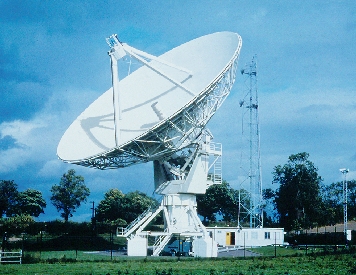The Multi-Telescope-Radio-Linked-Interferometer
In 1976 work began on the building of a 134 km array of telescopes linked by microwave radio links to Jodrell Bank.
MTRLI was an extension of the initial long baseline work at Jodrell Bank, both with the small transportable telescopes and later with the MKII and MKIII phase-stable interferometer. With a single interferometer it was possible to infer details about the structure of a radio source from the way that the fringe visibility varied as the effective baseline of the interferometer changed in length and position angle throughout the observation. But there was insufficient information to enable a radio image of the source to be made. Given an array containing a sufficient number of telescopes to significantly increase the number of baselines it was then possible to gain enough information about the source structure to build up a radio image. Three new 25m telescopes were built to add to the MKII, MKIII and Defford telescopes already operated by Jodrell Bank. These were located at Knockin, near Oswestry, Pickmere, north of Northwich, and Darnhall, south of Winsford.
The photograph shows the site at Knockin. The telescope was built by E-Systems and very similar to those making up the VLA in New Mexico. The low frequency feeds were mounted at the prime focus, as shown in the photograph, but they could be replaced with a secondary reflector for higher frequencies with the feed horn located in the tube at the centre of the dish and receiver in the vertex cabin below. The telescope is remotely controlled over a permanent telephone line and a signal derived from the atomic clock at Jodrell is received over an L-Band Link to lock the local oscillators used in the receiver system. A single hand of polarization was received and returned to Jodrell using a Ferranti microwave link having a 10 Mhz bandwidth.
The maximum baseline was 134 km, from Pickmere in the north to Defford in the south. With six telescopes in the array there were 15 baselines (( 6 x 5 )/2 ), but at low frequencies the MK1A could also be included to give 21 baselines. Techniques such as the use of "closure-phase" to remove the effects of the Earth's atmosphere and "clean" to remove the bad sidelobe structure resulting from a limited number of baselines were developed and excellent radio images were produced having a resolution better than that from Earth based optical telescopes.
In 1987 the MKII telescope was given a new aluminium reflecting surface which allowed it to be used at a frequency of 22 Ghz so, with the three E-Systems telescopes, giving a 4 telescope array at this frequency.
The initial name for the array was changed to MERLIN, standing for Multi-Element-Radio-Linked-Interferometer-Network, and plans were put in place to double its resolution and increase its sensitivity.



